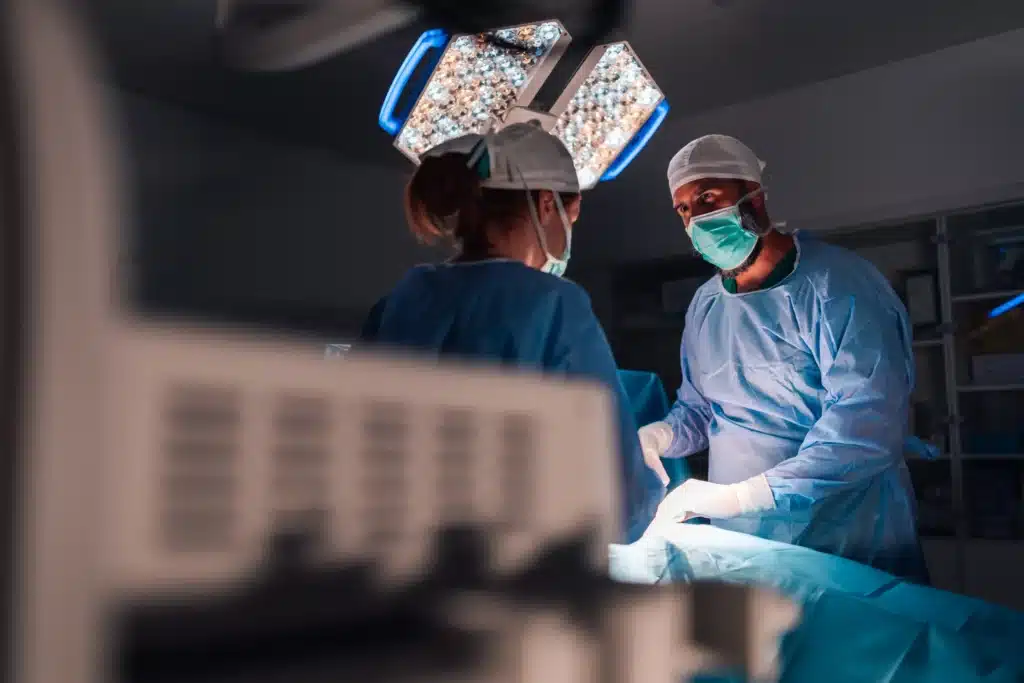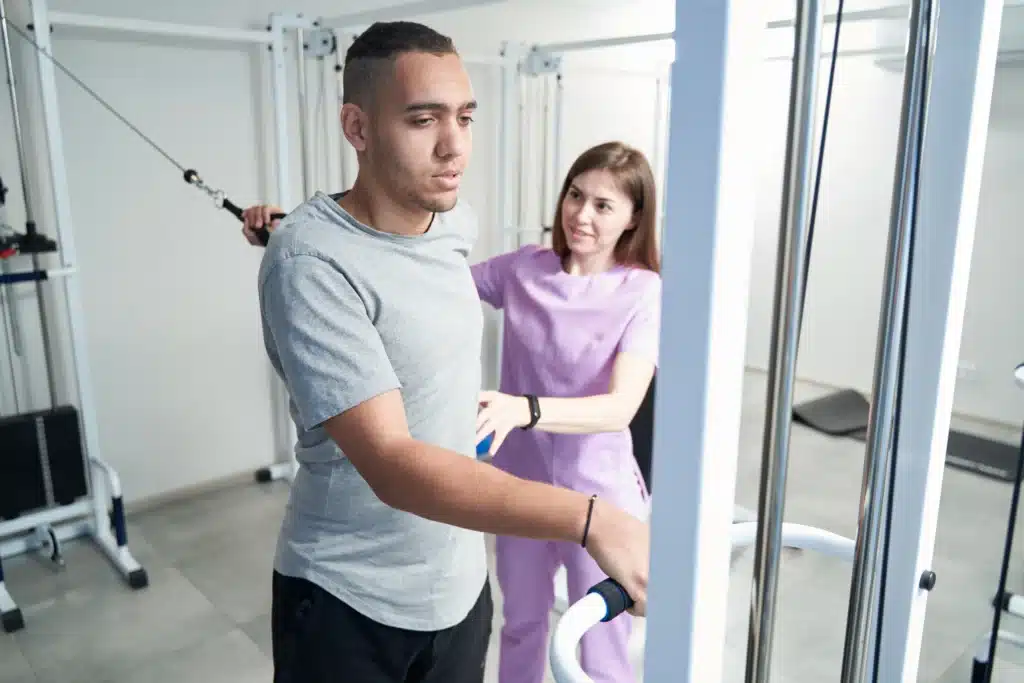
Table of Contents
ToggleWhen it comes to spinal fusion surgery, patients often worry about long recovery times and significant pain. This is where spinal fusion minimally invasive comes into play.
In contrast to traditional open surgery, which requires larger incisions and more muscle dissection, the minimally invasive approach allows me to access the spine using smaller incisions and specialized tools. In my 25 years of experience as a spine surgeon at Long Island Neuroscience Specialists, I’ve seen how this technique can transform patient outcomes, offering a faster recovery with less discomfort.
Spinal fusion involves fusing two or more vertebrae to stabilize the spine. In spinal fusion minimally invasive surgery, we use small instruments, often guided by a camera or robotic technology, to carefully fuse the vertebrae without causing unnecessary damage to the surrounding tissues.
This reduces the trauma to your body, meaning less pain post-surgery and a faster return to daily life. The most common types of minimally invasive spinal fusion include transforaminal lumbar interbody fusion (TLIF) and lateral interbody fusion (LIF), but the specific technique depends on the patient’s condition.
At Long Island Neuroscience Specialists, we specialize in spinal fusion surgeries to help patients find relief from chronic pain, nerve issues, and instability that affect their quality of life.

In my practice, I frequently recommend spinal fusion minimally invasive for a range of spinal conditions. It’s particularly effective for degenerative disc disease, which occurs when the intervertebral discs deteriorate, leading to pain and instability.
This surgery is also a great option for patients suffering from spinal stenosis, a narrowing of the spinal canal that compresses the nerves and causes significant discomfort. I’ve also used this technique to treat herniated discs, where the soft material inside a disc pushes out and presses on nearby nerves.
Patients with spinal deformities such as scoliosis or kyphosis can benefit from this procedure as well, as it helps correct the abnormal curvature of the spine. Lastly, for those dealing with spondylolisthesis—a condition where one vertebra slips forward over the one below it—minimally invasive fusion can provide stability and relief from pain.
These conditions are often debilitating, limiting daily activities and reducing the quality of life. What I love about spinal fusion minimally invasive is that it provides a solution with less recovery time and fewer complications compared to traditional methods, allowing my patients to regain their quality of life sooner. Read more here.
One of the biggest advantages I see with spinal fusion minimally invasive surgery is the reduced recovery time. Since this procedure requires smaller incisions, there’s less trauma to the muscles and tissues surrounding the spine, which translates to less pain after surgery.
Patients often experience a shorter hospital stay—sometimes going home the same day—and can return to normal activities faster than they would with open surgery. Another key benefit is the reduced risk of infection.
Smaller incisions mean fewer opportunities for bacteria to enter the body, making the procedure safer overall. Additionally, the minimally invasive technique leaves patients with smaller scars, which is a big plus for those concerned about cosmetic outcomes.
From my perspective as a spine surgeon, another critical benefit is the precision of the surgery. Using robotic technology and high-definition cameras, I can navigate the spine with extreme accuracy, ensuring that the fusion is done exactly where it needs to be.
This precision not only improves the chances of a successful surgery but also reduces the risk of complications, such as damage to nearby nerves. Lastly, there’s the psychological benefit. Many of my patients are understandably nervous about surgery, and the idea of a minimally invasive approach feels less daunting.
It’s easier to reassure someone that they’ll be up and moving again much sooner than they might expect, which reduces anxiety and fosters a more positive outlook on their recovery. Read more here.
Recovery after spinal fusion minimally invasive surgery varies depending on the individual and the specific procedure performed. In general, I tell my patients to expect several weeks to a few months of recovery time, although the exact timeline can depend on factors like age, overall health, and how well they adhere to post-op instructions.
The first few days after surgery are focused on managing pain and ensuring that the incision heals properly. I often prescribe pain medications, but we also encourage the use of ice packs and frequent short walks to reduce discomfort and promote circulation.
One thing I always emphasize is the importance of not staying in bed for too long—early mobility is key to a smooth recovery. Within a few weeks, most patients can begin light activities, and I’ll recommend starting physical therapy to strengthen the muscles around the spine and improve flexibility.
Physical therapy is crucial to ensuring that the spine stays stable and strong, preventing future issues. Full recovery can take a few months, but the good news is that with spinal fusion minimally invasive techniques, this timeline is much shorter than it would be with traditional open surgery.
The recovery process also involves regular follow-ups with me and the team at Long Island Neuroscience Specialists. During these appointments, we monitor the healing process and make sure the fusion is progressing as expected.
I always tell my patients that patience is key—rushing recovery can lead to complications, but following the post-op care plan sets the stage for a successful outcome.

I often get asked, “Am I a good candidate for spinal fusion minimally invasive?” The answer depends on several factors. First, we need to ensure that the specific area of your spine causing the problem can be accessed through small incisions.
This typically means that your condition is localized and well-defined, which is something we can determine through imaging tests like MRIs or CT scans. Candidates for this surgery usually include those who haven’t found relief from more conservative treatments like physical therapy, medication, or injections.
If you’ve tried these options without success and your pain persists or worsens, minimally invasive spinal fusion may be the next step. It’s also important to consider your overall health.
While spinal fusion minimally invasive is less taxing on the body than traditional surgery, it’s still a significant procedure. I’ll evaluate factors like your age, physical fitness, and any underlying health conditions to make sure you’re fit for surgery.
Patients who smoke or have diabetes, for example, may face a higher risk of complications, so we’ll need to discuss how to mitigate those risks beforehand. Ultimately, the decision to proceed with surgery is made collaboratively.
I work closely with each patient to weigh the benefits and risks, and we come to a conclusion based on their unique circumstances. One of the things I pride myself on at Long Island Neuroscience Specialists is our personalized approach to patient care.
While spinal fusion minimally invasive has many benefits, it’s important to acknowledge that, like all surgeries, it comes with some risks. One of the risks we watch out for is infection, though the chances are lower with minimally invasive surgery compared to open surgery due to the smaller incisions.
Another risk is nerve damage. Because we’re working so close to the spine and the delicate nerves that surround it, there’s always a possibility that the nerves could be irritated or damaged during the procedure. However, with the use of advanced imaging and robotics, we minimize this risk as much as possible.
Blood clots are another concern, particularly in the legs after surgery. This is why I emphasize early mobility—getting up and walking as soon as possible helps reduce the likelihood of developing clots.
Additionally, there’s a small chance of spinal fluid leaks, which can lead to headaches and other complications if not managed properly. In some cases, the fusion might not take, leading to what we call pseudarthrosis, where the bones don’t fully fuse together.
This can happen if patients resume heavy activity too soon or don’t follow post-op instructions. It’s crucial to adhere to the recovery plan to avoid this.
Lastly, there’s always a chance that the surgery won’t fully relieve the patient’s pain, or it could cause a different type of discomfort at the site of the graft. However, in my experience, the vast majority of patients experience significant pain relief and improved quality of life following spinal fusion minimally invasive surgery.
Preparing for spinal fusion minimally invasive surgery is just as important as the surgery itself. One of the first things I tell my patients is to stop smoking if they’re smokers.
Smoking can delay healing and increase the risk of complications. It’s also important to stop taking any medications that could interfere with the surgery, such as blood thinners, and to follow the fasting guidelines we provide.
In the weeks leading up to surgery, I encourage my patients to stay active. Engaging in light physical activity can help keep the muscles strong and make recovery easier.
We’ll also conduct imaging tests to map out the surgery in detail, ensuring that we have a clear view of the problem area before the operation begins. Finally, planning for after surgery is crucial as well.
I always advise my patients to arrange for someone to help them at home during the first few days after surgery. This includes assistance with daily activities like cooking, cleaning, and transportation to follow-up appointments.
Having a solid support system in place can make a big difference in how smoothly your recovery goes.
On the day of the surgery, you’ll need to arrive at the hospital or surgical center early, as there will be pre-operative procedures to complete.
This includes signing consent forms and undergoing a final health check to make sure you’re ready for surgery. The anesthesiologist will review the anesthesia plan with you, whether it’s general anesthesia (putting you completely to sleep) or local anesthesia with sedation (numbing the area but keeping you awake).
Mentally preparing for surgery is also important. I always take the time to talk with my patients beforehand to address any concerns they may have.
Surgery can be a stressful experience, but knowing exactly what to expect can alleviate a lot of that anxiety.

The success of spinal fusion minimally invasive surgery is something I’m proud to discuss with my patients. Generally, the success rate of this surgery is high, especially when the patient is a good candidate and follows the post-operative care plan.
In my 25 years of experience, I’ve seen excellent outcomes in patients with conditions like herniated discs, spinal stenosis, and spondylolisthesis. Success is measured in a few different ways. First and foremost, we look at pain relief.
Most patients experience a significant reduction in pain after their surgery, often within the first few weeks. Improved mobility is another key marker of success.
Patients who couldn’t stand, walk, or bend without pain often regain these abilities as their spine stabilizes and heals. Long-term results also depend on the condition being treated.
For example, patients with degenerative disc disease often see lasting benefits from the fusion, as it prevents further deterioration of the affected discs. Similarly, those with scoliosis or spinal deformities benefit from the long-term stability that the fusion provides, preventing further progression of the curve.
Of course, no surgery is without its risks, and there’s always a possibility that symptoms may persist or new issues may arise over time. However, with proper candidate selection and adherence to the recovery process, the vast majority of patients achieve a successful outcome.
The key is to maintain realistic expectations and understand that while spinal fusion minimally invasive can dramatically improve your quality of life, it’s not a cure-all. That’s why we always focus on personalized care plans at Long Island Neuroscience Specialists, ensuring each patient receives the treatment that’s right for them.
If you’ve been researching your surgical options, you’ve probably come across the term “open spinal fusion” and might be wondering how it compares to spinal fusion minimally invasive. In my experience, there’s a significant difference between the two approaches, both in terms of patient experience and recovery outcomes.
Traditional open surgery requires a long incision along the back, and the surgeon needs to retract a large amount of muscle and soft tissue to access the spine. This leads to more postoperative pain, longer hospital stays, and a much longer recovery time.
In contrast, minimally invasive surgery uses small incisions and specialized tools to avoid disrupting the muscles around the spine. The result is far less pain, less bleeding during surgery, and a quicker recovery.
For many patients, the idea of a faster recovery is one of the main reasons they opt for spinal fusion minimally invasive. While traditional open surgery can take several months to recover from, many of my minimally invasive spinal fusion patients are back to their normal activities within a few weeks.
Additionally, the risk of infection and other complications is lower with the minimally invasive approach, thanks to the smaller incisions and shorter hospital stays. That being said, there are some cases where traditional open surgery is the better option.
For example, if the spinal condition is particularly complex or if the surgeon needs to access multiple levels of the spine, open surgery may provide better visibility and access. As always, the decision between the two approaches should be made based on the specific needs of the patient, and I always take the time to discuss both options with my patients during their consultation.
As with any surgery, the success of spinal fusion minimally invasive depends largely on the skill and experience of the surgeon performing the procedure. At Long Island Neuroscience Specialists, we pride ourselves on offering the highest level of expertise in minimally invasive spine surgery.
With over 25 years of experience in the field, I’ve personally performed hundreds of these procedures, and our team is dedicated to ensuring that every patient receives the best possible care. Choosing the right surgeon is critical because minimally invasive surgery requires specialized training and expertise.
Not all spine surgeons are trained in the use of advanced tools like robotic systems or endoscopic cameras, which are essential for the success of this type of surgery. When selecting a surgeon, it’s important to ask about their experience with minimally invasive techniques and the outcomes of their past patients.
In addition to experience, I always emphasize the importance of a multidisciplinary approach to spine care. At Long Island Neuroscience Specialists, our team includes not just surgeons, but also physical therapists, pain management specialists, and neurologists.
This comprehensive approach ensures that every aspect of your care is coordinated, from pre-surgery preparation to post-operative rehabilitation. Ultimately, the goal is to provide you with the best possible outcome and help you return to your normal activities as quickly as possible.
Whether you’re dealing with chronic pain, mobility issues, or a more complex spinal condition, spinal fusion minimally invasive can offer a solution that’s both effective and minimally disruptive to your life.

Once you’ve undergone spinal fusion minimally invasive surgery, the next step is ensuring a smooth and successful recovery. I always tell my patients that the surgery is just one part of the process.
The real key to long-term success lies in what you do after the procedure to promote healing and maintain the health of your spine. The first few days after surgery are all about managing pain and protecting the incision site.
I encourage my patients to walk as much as they’re able to because gentle movement helps prevent blood clots and promotes circulation. Walking also stimulates the healing process, helping your muscles stay active without putting too much strain on your back.
However, it’s crucial not to overdo it. I always emphasize the importance of listening to your body—if something hurts or feels off, it’s important to slow down and let your body rest.
Physical therapy is another essential part of the recovery process. Most of my patients start physical therapy within a few weeks of their surgery.
The goal of physical therapy is to strengthen the muscles around the spine and improve flexibility, helping to support the fused vertebrae and prevent future issues. Your therapist will guide you through exercises that are safe for your back and help you regain mobility without putting strain on the surgical site.
It’s also important to follow all post-surgery instructions carefully. This includes avoiding heavy lifting, bending, or twisting for several weeks after surgery.
Wearing a back brace, if recommended, can help support your spine as it heals, reducing the risk of complications. Proper incision care is crucial to avoid infection, so keep the area clean and dry, and notify your doctor if you notice any redness, swelling, or drainage from the incision site.
One of the most common questions I get from patients is about the long-term results of spinal fusion minimally invasive surgery. The good news is that for most patients, this surgery provides lasting relief from pain and a significant improvement in mobility.
Once the vertebrae are fused, they remain stable, preventing further deterioration of the spine in the affected area. However, it’s important to understand that spinal fusion limits movement in the fused section of the spine.
While this typically doesn’t cause any noticeable restrictions in daily activities, it can sometimes place extra stress on the vertebrae above and below the fusion site. This is something we monitor during follow-up appointments, and physical therapy can help strengthen the surrounding muscles to minimize this risk.
Long-term spine health also depends on maintaining a healthy lifestyle. I always recommend that my patients stay active—regular exercise helps keep the muscles around the spine strong, which is essential for maintaining stability.
Low-impact activities like swimming, walking, and cycling are particularly beneficial for spine health.
Weight management is another important factor. Excess weight can put additional stress on the spine, which can lead to further complications down the road.
I work closely with patients to develop a plan for staying active and managing their weight to ensure the best possible long-term outcome. Finally, I encourage my patients to stay engaged with their spine health.
Regular check-ups with your surgeon or primary care provider can help catch any potential issues early and ensure that your fusion is holding up as expected. With the right care and attention, spinal fusion minimally invasive can provide a lifetime of relief from chronic back pain.
As a spine surgeon with over 25 years of experience, I’ve seen firsthand how spinal fusion minimally invasive surgery can transform lives. This technique allows us to address serious spinal conditions with far less trauma to the body, resulting in shorter recovery times, reduced pain, and better overall outcomes for patients.
At Long Island Neuroscience Specialists, we’re proud to offer this cutting-edge approach to spinal care. Our team is dedicated to providing personalized, comprehensive care to each and every patient, from the initial consultation all the way through recovery.
If you’re suffering from chronic back pain and conservative treatments haven’t provided relief, spinal fusion minimally invasive could be the solution you’ve been looking for. We’re here to answer any questions you might have and help guide you through the decision-making process.
With the right treatment plan and expert care, you can get back to living the life you want—pain-free and active.
If you’d like to learn more about spinal fusion minimally invasive surgery and find out if you’re a candidate, feel free to reach out to Long Island Neuroscience Specialists. Our team of experts is here to guide you through every step of the process, ensuring that you receive the highest level of care and support.
We’ll work with you to create a personalized treatment plan designed to meet your specific needs and help you achieve lasting relief from back pain.
GET IN TOUCH +
285 Sills Road
Building 5-6, Suite E
East Patchogue, NY 11772
(631) 475-5511
184 N. Belle Mead Road
East Setauket, NY 11733
(631) 675-6226
GET IN TOUCH +
285 Sills Road
Building 5-6, Suite E
East Patchogue, NY 11772
(631) 475-5511
184 N. Belle Mead Road
East Setauket, NY 11733
(631) 675-6226
SUBSCRIBE TO OUR NEWSLETTER +
Send us a Google review. Click this link and let us know how we did!
Review us on Yelp too.